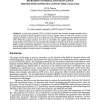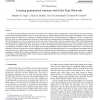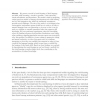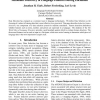482 search results - page 12 / 97 » Structural Equations in Language Learning |
PARLE
1987
13 years 11 months ago
1987
A context-freegrammar(CFG)in GreibachNormalForm coincides,in anothernotation,witha system of guarded recursion equations in Basic Process Algebra. Hence to each CFG a process can b...
IUI
2006
ACM
14 years 1 months ago
2006
ACM
Sketch interfaces provide more natural interaction than the traditional mouse and palette tool, but can be time consuming to build if they have to be built anew for each new domai...
NN
2007
Springer
13 years 7 months ago
2007
Springer
Echo State Networks (ESNs) have been shown to be effective for a number of tasks, including motor control, dynamic time series prediction, and memorizing musical sequences. Howeve...
ALIFE
2010
13 years 6 months ago
2010
We present a model of social learning of both language and skills, while assuming—insofar as possible—strict autonomy, virtual embodiment, and situatedness. This model is built...
LREC
2008
13 years 9 months ago
2008
Data Selection has emerged as a common issue in language technologies. We define Data Selection as the choosing of a subset of training data that is most effective for a given tas...




